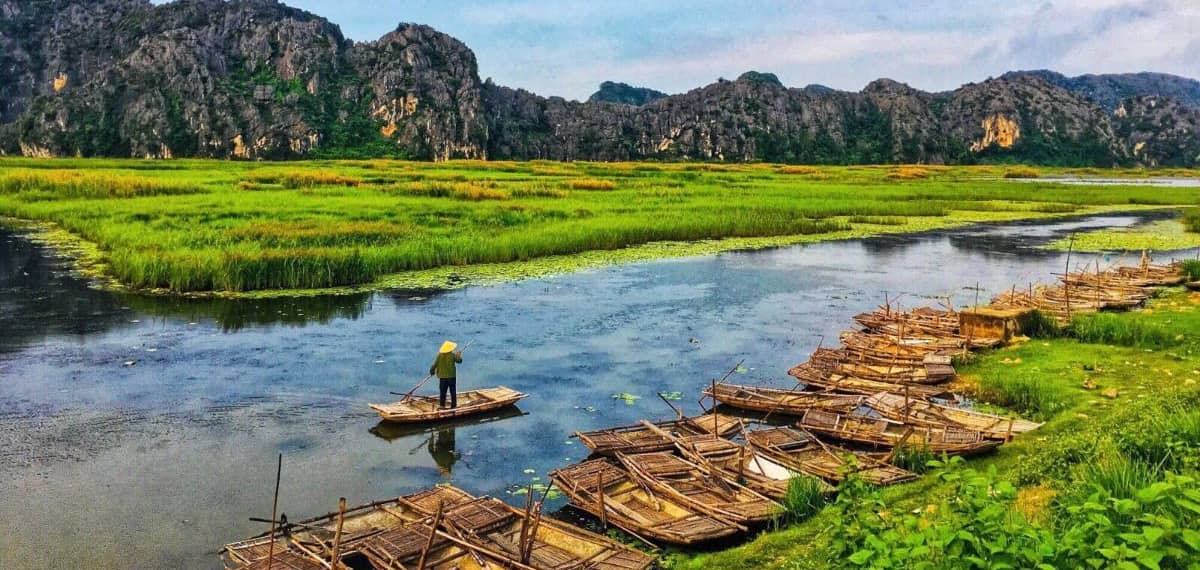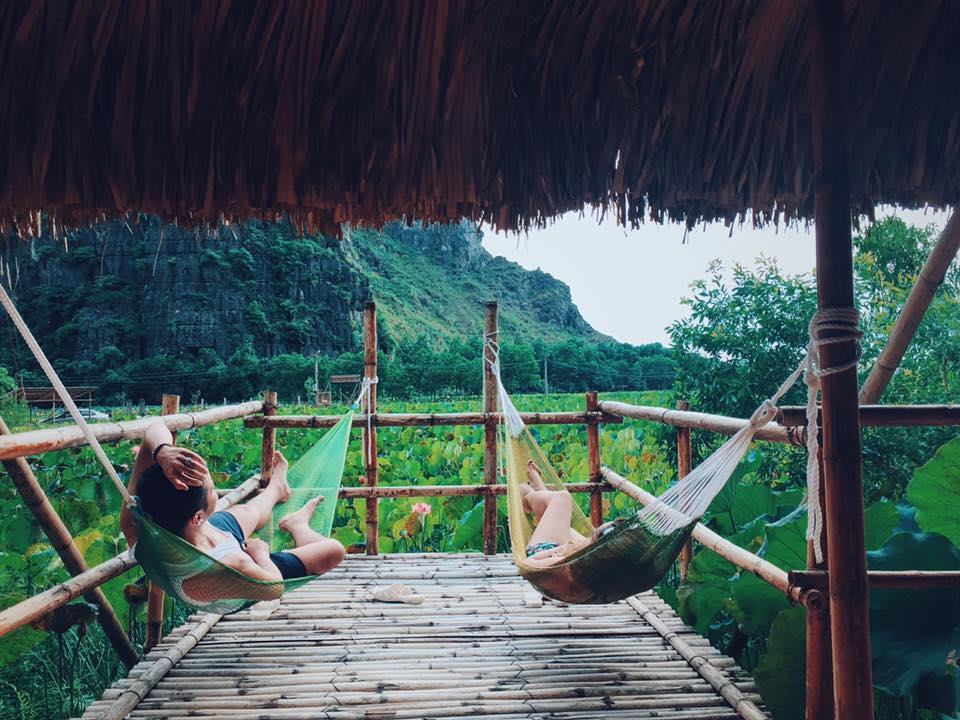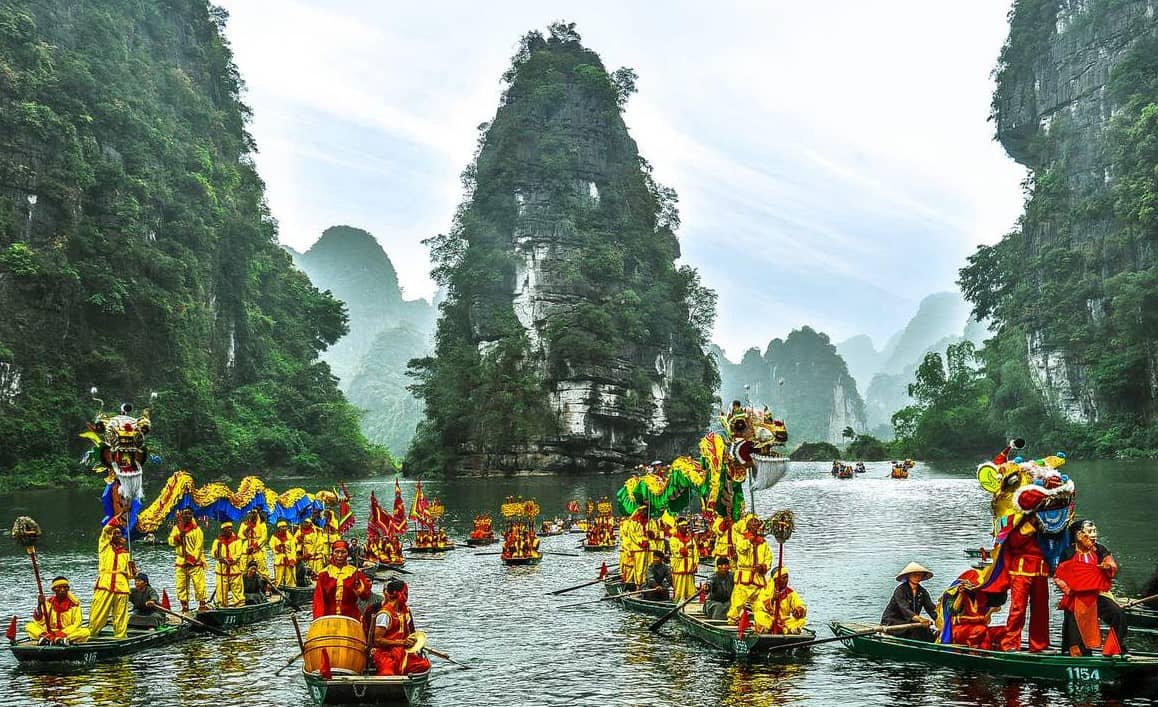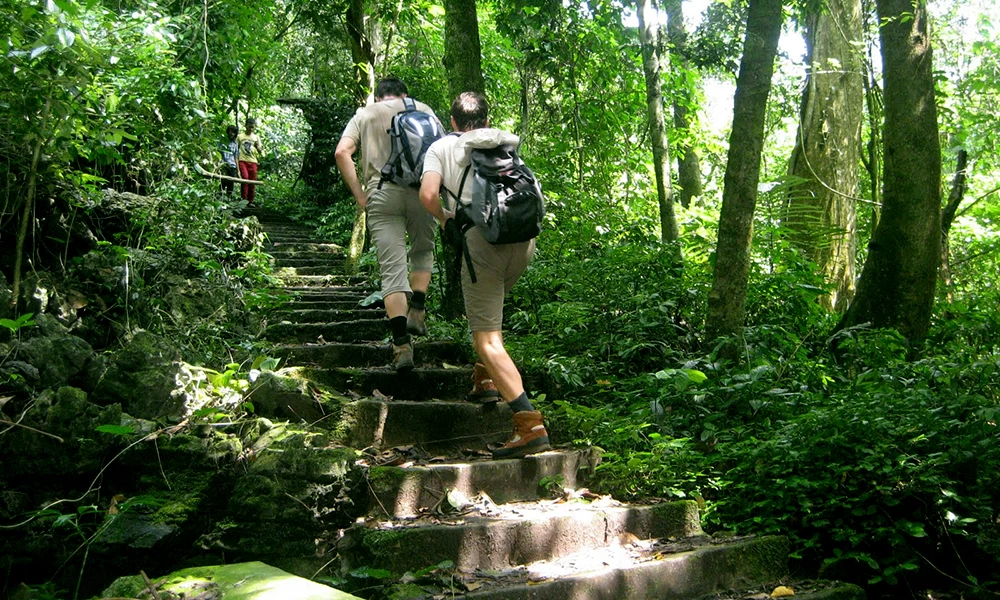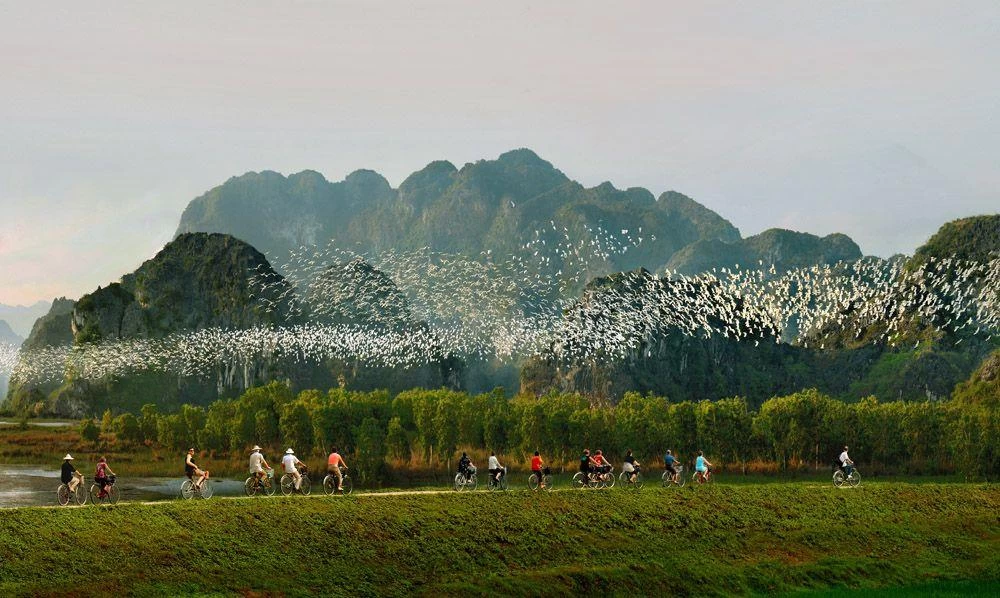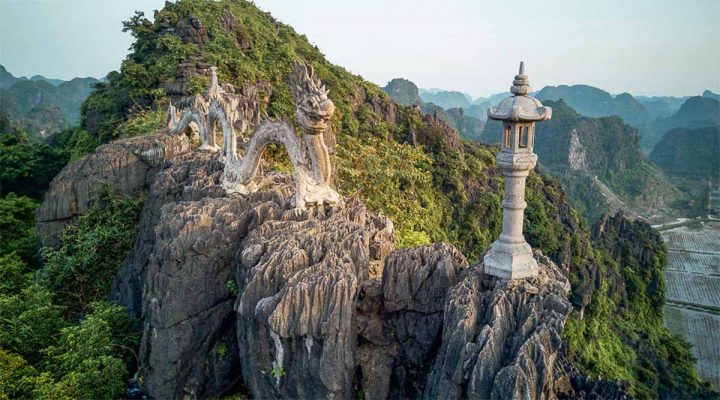
Mua Cave.
Mua Cave is not just a simple cave; it’s a tourist complex, encompassing numerous beautiful landscapes, resorts, and recreational areas, dubbed a miniature “Great Wall of China.”
I. INTRODUCTION TO MUA CAVE
The Mua Cave tourist area is a natural complex spanning over 4 hectares, including numerous caves and majestic limestone mountains. Situated within the core area of the Trang An World Heritage Site, Mua Cave exhibits the characteristic geological features of the limestone mountains, which have existed for millions of years.
Featuring the unique and renowned natural observation deck in Ninh Binh, perched atop Mua Mountain at an altitude of 142 meters, with 486 white stone steps leading to the summit, this is where visitors can admire the panoramic view of the Tam Coc region, Trang An, and the famous Ngo Đong River. Due to its pristine beauty, Mua Cave is celebrated with poetic names such as “Tam Coc Maiden,” “Queen of Trang An,” or “Vietnam’s Great Wall.”
1. Origin of the name “Mua Cave”
The name “Mua Cave” originates from a legend that tells of ancient times when King Trần returned to the former capital of Hoa Lư and established Am Thai Vi. People often visited a cave located beneath a bell-shaped mountain to enjoy the performances of beautiful dancing maidens. Hence, the place was named Mua Cave. Later, the local people colloquially referred to this land as Mua Cave, indicating the surrounding mountainous and riverine landscape.
2. Location of Mua Cave
The Mua Cave tourist area in Ninh Binh is situated on the majestic Ngọa Long Hùng Vĩ Mountain, approximately 10km from the city center of Ninh Binh and 100km from the capital, Hanoi. It is one of the key tourist destinations within the Trang An World Heritage Site.
Despite being surrounded by many famous scenic spots in Ninh Binh such as Bai Dinh Pagoda, Trang An, Tam Coc, and Hoa Lu, Mua Cave still possesses its own unique and prominent beauty. This destination is particularly favored by many tourists, especially international visitors.
To behold the magnificent natural scenery and the vast golden rice fields of Tam Coc, you must reach the mountaintop. You’ll need to overcome the challenge of climbing 486 stone steps, flanked by majestic relief carvings of dragons and phoenixes.
II. GUIDE TO GETTING TO MUA CAVE
Mua Cave is located less than 100km from Hanoi, making it relatively easy to choose transportation options. Here are some means of transportation and routes for you to choose from according to your preference:
Motorbike: If you’re up for an adventure and want to explore Mua Cave in Ninh Binh, a motorbike is an excellent choice. From the center of Hanoi, travel along the old National Highway 1A through Ha Nam, then head towards Ninh Binh and Thanh Hoa. Upon reaching Ninh Binh City, follow the signs to Trang An, turning left. Continue along Route 491C until you reach Khe Dau Ha village. From there, just go straight ahead, and you’ll find Mua Cave. The road is smooth and easy, without any major challenges.
Bus: If you’re not confident in your driving skills or prefer a more relaxed option, you can choose to take a bus. There are currently bus routes to Ninh Binh from My Dinh and Giap Bat bus stations. With a fare of around 150,000 VND and a travel time of about 2 hours, you’ll arrive at Ninh Binh. From there, you can take a motorcycle taxi or regular taxi.
Train: For a unique experience, try taking the train. There are several train routes passing through Ninh Binh, taking approximately 1.5 to 2 hours. The train will stop at Ninh Binh station.
III. BEST SEASONS TO VISIT MUA CAVE
1. Spring: from March to May
During spring, the landscape at Mua Cave becomes vibrant and colorful with various blooming flowers. The weather is usually cool and comfortable for exploration activities.
2. Rice harvest season: from May to June
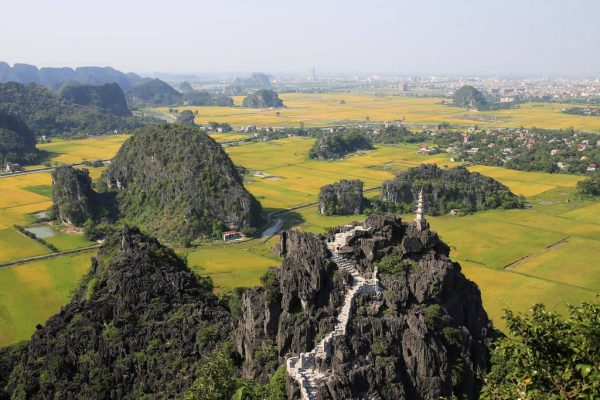
Mua Cave in the rice harvest season
During this time, the entire area shines with the golden color of ripe rice fields, presenting a harmonious natural scene. And only from a high point like the summit of Mua Cave can visitors fully appreciate its enchanting beauty. However, even outside the rice harvest season, the lush greenery of the mountains and forests here is enough to awe visitors.
3. Lotus season: from June to August
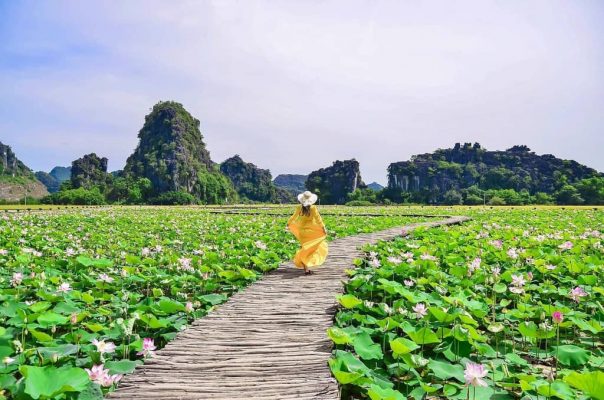
Mua Cave during lotus blooming season
According to my travel experience, this is one of the most beautiful times of the year. Sitting on a heart-shaped bridge or trying boating, you’ll witness the stunning beauty of blooming lotus flowers up close. Choose your best outfit and come here to capture impressive moments.
Start your journey with: Hanoi to Ninh Binh in 3 Days
4. Autumn: from September to November
Autumn is also a wonderful time to visit Mua Cave. During this period, the weather transitions from the heat of summer to the coolness of winter, providing comfortable conditions for sightseeing and exploration.
IV. THE UNIQUE ARCHITECTURE OF MUA CAVE
As a tourist complex, the highlight of Mua Cave is the Mua Mountain area, which also boasts unique architecture. The path to the top of Mua Mountain is built with architectural elements reminiscent of the Great Wall, with many likening it to the “Great Wall of Vietnam.”
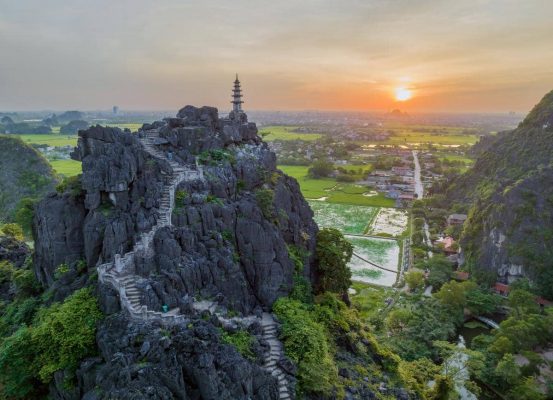
Architecture is likened to a miniature Great Wall
The path is constructed with white stone steps totaling 486, leading up to the summit. Over time, the path takes on a serene beauty, adorned with moss and lichen. At the mountain peak, there are towers resembling those found in temples and pagodas, with sharp peaks and curved, vaulted roofs. At the beginning of the mountain ascent is a dragon sculpture crafted with finesse, seemingly inviting tourists to conquer the path to the summit.
At the mountain top is a dragon statue guarding a deep-seated statue of Quan Am Bodhisattva. The dragon atop the mountain not only guards the Bodhisattva but is also likened by many to embracing the sunrise and sunset when viewed from the foot of the mountain. This dragon is also the “tallest” in Ninh Binh and contributes to the unique architecture atop Mua Mountain.
Along the path to the mountain top, various animal sculptures, such as unicorns and eagles, appear, representing creatures with spiritual significance in Vietnamese architectural culture. These sculptures are placed on stone pillars along the path, adding a special and impressive touch to the journey to the mountain top.
Learn more about: Discover Ninh Binh Day Trip from Hanoi for Best Experiences
V. SPECIAL FEATURES OF MUA CAVE
1. Breathtaking Check-in at the Summit of Ngoa Long Mountain
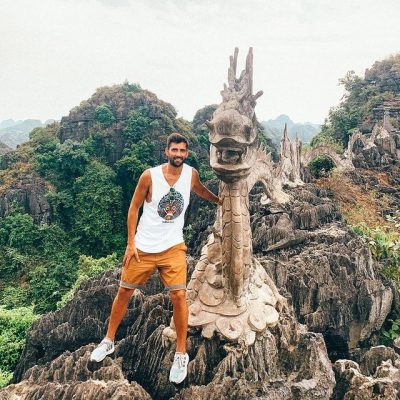
Ngoa Long Peak – attractive check-in point
From my experience traveling to Mua Cave in Ninh Binh, it’s evident that this place isn’t for the faint-hearted. With nearly 500 stone steps from the foot of the mountain to the summit, it’s quite an endeavor, but the reward is the stunning panoramic view of the Ninh Binh mountains, rivers, and countryside from above.
It would be a shame to visit here without experiencing the journey of climbing these steps yourself. Along the way, the rocky mountains and surrounding fields create a majestic landscape akin to a fairyland. Every spot along the path offers opportunities for incredibly picturesque photographs.
After conquering the 500 stone steps, you’ll discover a vast landscape of the Ninh Binh region. This is a paradise for photo enthusiasts, with impressive photos capturing even a somewhat eerie beauty that leaves a strong impression on visitors. From the summit of Mua Cave, you’ll overlook the vast fields of Tam Coc- Bich Dong and the Ngo Đong River, with boats ferrying tourists for sightseeing.
Do not miss: Ninh Binh Tour in 2 Days
2. Lotus Pond at Mua Cave
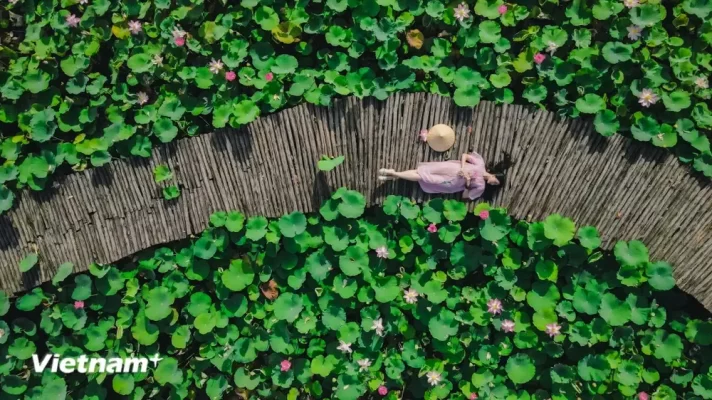
Lotus Pond at Mua Cave
Ninh Binh isn’t just beautiful during the rice harvest season; it’s also stunning during the lotus season. Mua Cave is one of the places with many beautifully blooming lotus ponds.
In late May and early June, during the lotus season, you’ll not only see lotus flowers blooming at Mua Cave but also at many other places like Tam Coc, Bich Dong, and Trang An along your journey through the region.
Capturing photos during the lotus season will preserve beautiful memories for you. The best time to take photos is early in the morning (5–6 am), when the lotus flowers are still dewy and the sun begins to rise over Mua Cave. Besides bringing your own outfits, you can easily rent unique costumes for your special photo shoots.
You will be like: Ninh Binh to Halong Bay – Heritage Road Journey 4D3N
3. Watching the Sunrise and Sunset at Mua Cave
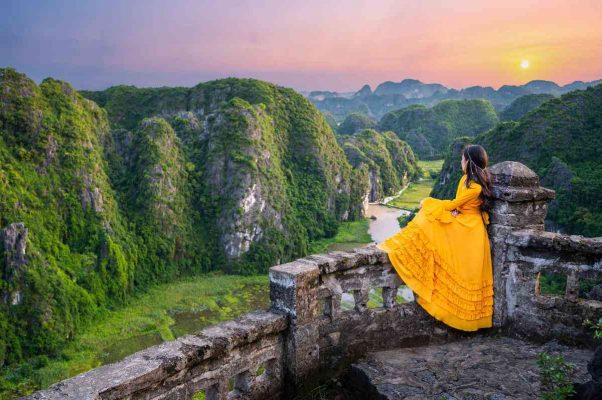
The beauty of the sun rising over the top of the mountain
One of the memorable experiences that tourists can try is watching the sunrise and sunset at Mua Cave. The ideal time to watch the sunrise is from 5:00 a.m. to 6:00 a.m., or from 5:00 p.m. to 6:00 p.m. for sunset. Tourists can check the expected sunrise or sunset times on weather apps to “catch” the exact time to enjoy these beautiful moments.
VI. TRAVEL TIPS FOR VISITORS
Below are a few small travel tips for tourists to have a perfect trip.
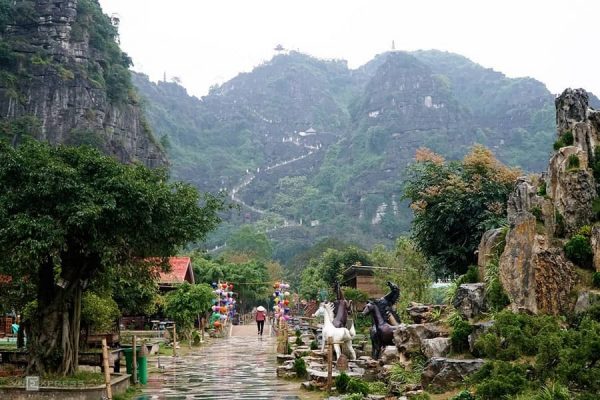
The way to the Mua Cave
- To reach the summit of Mua Cave, visitors will have to climb nearly 500 steps. Therefore, sports shoes would be a suitable choice instead of high heels.
- Be sure to bring a small water bottle to stay hydrated during the journey to conquer the summit of Mua Cave!
- Besides the mountain peak, you can check in at any location. Therefore, instead of waiting in line, visitors can take advantage of quieter moments to take photos on the empty steps.
- Limit carrying heavy items, as they will make you more tired.
- The entrance fee to the Mua Cave tourist area is 100,000 VND per person.
- Additionally, you should also avoid taking photos in unsafe locations!
- It’s best to visit in the morning to avoid harsh sunlight and crowds. You’ll capture beautiful photos during the sunrise.
Let’s discover: Northern Vietnam Itinerary




